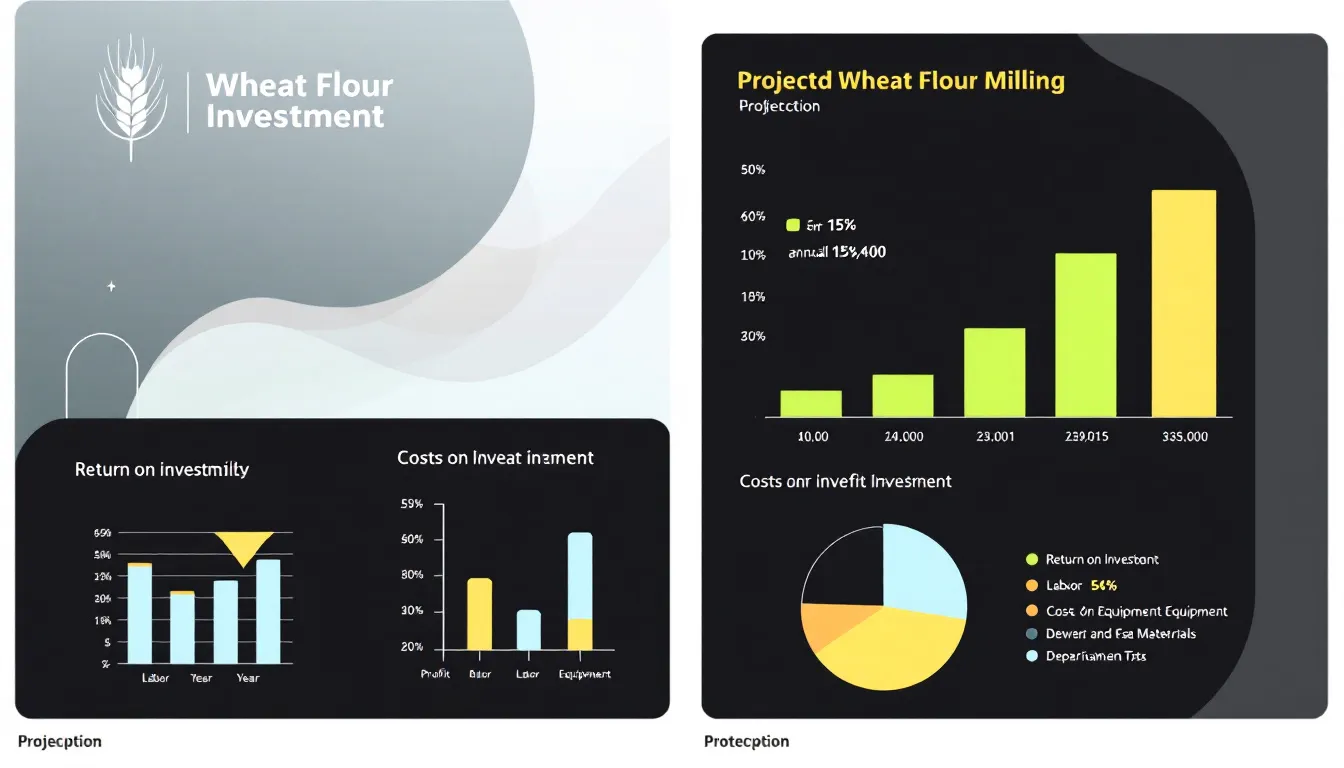Planning to start a wheat flour mill business? This wheat flour mill project report provides essential insights into costs, steps, and business plans. Whether you’re considering a small-scale or large-scale operation, this guide will help you navigate the process to ensure success.

The wheat flour milling sector is a cornerstone of the food industry, transforming wheat into flour for various everyday food products. This business falls under the food processing industry, which is vital for daily dietary needs. Starting a flour mill is a promising venture in areas with high flour consumption and requires relatively low capital investment, making it accessible for small businesses.
Profit margins in the flour milling industry range from 10% to 20%, influenced by operational efficiency. With high demand and strategic investment, starting a wheat flour production plant is seen as a lucrative and comparatively easy business idea.
Typically, it may take between 6 to 12 months to become fully operational. Careful planning and effective marketing are key to establishing a successful flour milling business.
Wheat flour milling operations are predominantly divided into two types: small scale and large scale. Small scale flour mills are typically designed to handle lower processing capacities compared to their large scale counterparts, which can reach up to 500 tons per day.
Choosing between these types of mills should be based on your specific situation, considering the market demand and your investment capacity.
Small scale flour mills offer significant flexibility in operations, allowing producers to adjust production based on market demand. These mills are relatively easy and simple to operate, making them an ideal choice for new entrepreneurs. The investment for mini flour mill setups generally ranges from $2,500 to $3,000, while small plants might require between $3,500 to $5,000.
Small scale flour mills require little capital, making them attractive for those with limited resources. However, the profit margin for this small flour mill business is relatively modest.
You can start a grain flour business either with moderate capital investment or by utilizing a small retail space with low investment. These mills can charge for milling services or produce wheat flour milling business for sale.
Despite the smaller scale, they play a crucial role in local markets, providing an affordable flour milling option and ensuring continuous flour production.
Large scale flour mill projects require significant investment in advanced machinery and technology. While the financial requirements are substantial, the benefits include meeting high global demand and producing high-quality flour on a larger scale.
The continuous assembly line process in large scale flour mills minimizes manual labor and enhances production efficiency. Investing in high-quality machinery, such as a flour milling machine offered by PINGLE MACHINERY, can significantly improve operational efficiency in wheat flour production lines.
These mills are designed to cater to large markets, ensuring the supply of refined flour and other wheat flour products from a flour mill factory on a large scale, including packaged flour.

The costs of setting up a wheat flour mill vary depending on the scale of the operation. Here’s a breakdown of the estimated costs:
Staffing costs for a flour mill can vary from INR 30,000 to INR 60,000, influenced by the number of employees required. Registration and licensing expenses can also add up, costing around INR 10,000 to INR 30,000. Several factors affect the overall cost, including the type of milling technology, price of raw materials, and scale of operations.
Customization of the production line, grinding fineness, capacity, and installation area also influence the cost of wheat flour milling equipment. Grasping these costs is essential for effective financial planning and the sustainability of your flour mill business.

Several key steps are involved in establishing a wheat flour mill business: conducting market analysis, selecting an appropriate site, choosing the right machinery, and ensuring proper installation and commissioning. Each of these steps requires detailed planning and consideration of various factors such as costs, market demand, and operational efficiency.
A comprehensive business plan for a flour mill should include a market analysis to identify demand and competition. Understanding local market dynamics and competition can significantly impact the financial returns of a flour mill business. Additionally, understanding both local and global market trends is crucial for estimating the financial requirements before launching the mill.
An ideal location for a flour mill should have good access to wheat supplies and shipping routes. Convenient transportation for raw materials and final product shipping is critical. Compliance with local zoning laws and considering future growth potential are also critical factors in site selection. A site near farms is recommended to ensure access to fresh and pure grains.
Choosing the right wheat flour milling machinery is vital for your flour mill business’s success. Key factors to consider include the capacity of the machinery, investment cost, milling process, and the type of raw materials used. The choice of machinery should align with your desired production capacity and available budget.
High-quality milling machinery, including automatic wheat mill machinery and a wheat flour machine, can enhance efficiency, reduce operational costs, and improve profitability. Essential machinery includes:
These components are critical for setting up an effective and efficient flour production line.
After purchasing the necessary wheat milling machinery, the next step is installation and commissioning. A complete flour mill plant layout comprises specific sections for different functions. These include areas for raw material storage, milling machines, and packaging. The initial step in the wheat flour milling process involves cleaning unwanted foreign particles from the wheat.
The milling process includes wet grinding, where different moisture levels and grades of wheat grains are blended. Separators, middling purifiers, and aspirators are used to clean and separate the wheat during the milling process. Sifting and grinding middlings help achieve different grades of wheat flour.
Tempering and conditioning control moisture content to peel away bran during grinding. An entoleter is used to separate unsuitable cracks in flour manufacturing.
A comprehensive business plan is vital for launching a flour milling operation. Establishing a flour mill requires financial backing, with costs varying based on the scale of operations and equipment needed. Understanding profit potential and evaluating the need for loans are important financial considerations before starting your flour mill business plan.
For those lacking sufficient starting capital, securing funding through bank loans or partnerships is essential. Bank-approved project reports for Mudra, PMEGP, and MSME loans are available for flour mill businesses.
The wheat flour business typically requires low investment, has high demand, and offers a high return on investment. If funds are insufficient, bank loans or finding a partner are suggested financial options.
Operating a flour mill legally requires obtaining a milling license and complying with local regulations. In India, this includes acquiring a food processing license, business registration, and environmental clearances. Ensuring all licenses, permissions, and registrations are completed before launching your wheat flour business is vital.
Before launching a flour mill, compliance with regulatory requirements, such as obtaining an FSSAI license, is necessary. The basic requirements for a flour milling factory include licensing and adhering to local regulations. This ensures smooth operation and avoids legal complications.

Effective marketing strategies are crucial for successfully promoting wheat flour products. Using technology, like marketing automation tools, can streamline marketing campaigns for flour businesses. QR codes on packaging can engage customers by leading them to digital content such as recipes and promotions.
Personalization in eCommerce marketing is crucial for connecting with customers in the flour industry. Additional digital marketing strategies include influencer marketing and pay-per-click (PPC) advertising.
B2B marketing strategies should focus on building relationships and meeting the specific needs of bakery and restaurant clients. Collaborating with influencers and food bloggers can significantly expand reach and credibility. Developing a strong brand image is vital for attracting and retaining customers in the competitive flour market.

A flour mill’s profitability often hinges on its ability to provide high-demand products like bran, corn flour, and wheat flour. Factors contributing to profitability include market demand, operational efficiency, raw material costs, and product quality. Locations with lower competition and high demand for flour products typically yield better profit margins.
In India, the wheat flour business is particularly profitable due to the increasing demand. By focusing on production efficiency and maintaining high quality, a flour mill business can ensure substantial returns on investment. Understanding these factors and incorporating them into your business plan can help you achieve financial success.
A small scale flour mill unit requires a minimum of approximately 3000 sq ft, while small to medium-sized mills typically need around 1-2 acres of land. Larger flour mills naturally require more land compared to small and medium mills. The cost of land acquisition for smaller mills can range between INR 2 lakhs to INR 3 lakhs, while for larger mills, it can be between INR 10 lakhs to INR 15 lakhs.
Access to raw materials and convenient transportation are essential considerations when selecting a location for a flour mill. Choosing a location with easy access to transportation can significantly enhance the efficiency of the flour mill business. These factors play a crucial role in ensuring smooth operations and timely delivery of products.
Several government schemes and subsidies support the establishment of flour mills. Programs such as PMEGP, Mudra Loan, and NABARD Support offer financial assistance and incentives for entrepreneurs. These subsidies and incentives can significantly reduce the financial burden and make it an affordable flour milling option.
Leveraging these options can help you secure the necessary funding and support for your flour mill project.
Conducting a SWOT analysis is essential for any business plan. Strengths may include the high demand for wheat flour and the low investment required. Weaknesses could be the initial setup costs and regulatory compliance required.
Opportunities might involve expanding into new markets or introducing innovative products. However, threats such as market competition and fluctuating raw material costs should be considered. This analysis helps in understanding the basic factors influencing your business and preparing for potential challenges.
Purchasing our project report provides clarity and insights that enhance decision-making throughout the project lifecycle. A comprehensive project report helps identify potential risks early, allowing for proactive management and mitigation strategies. It improves visibility into project performance, enabling better tracking of goals and objectives.
Structured reporting assists in maintaining control over project quality and adherence to standards. Additionally, a project report can inform future business decisions by providing valuable lessons learned from prior projects.
Investing in a project report is a crucial step towards ensuring the success and sustainability of your flour mill business.
In summary, establishing a wheat flour mill business involves careful planning and execution. From understanding the types of milling operations and costs involved to selecting the right machinery and navigating legal requirements, each step is crucial for success. By leveraging effective marketing strategies and conducting a thorough SWOT analysis, you can ensure profitability and a high return on investment.
Starting a flour mill business is not just an entrepreneurial venture but a step towards contributing to the food industry. With proper planning, strategic investment, and a comprehensive project report, you can tap into the high demand for wheat flour and build a sustainable and profitable business. Embrace the journey, and let your flour milling business flourish.
The initial costs for setting up a small scale flour mill typically range from INR 50,000 to INR 1 lakh, assuming you already own the land. This investment is crucial for establishing your milling business effectively.
To operate a flour mill in India, you need a food processing license, business registration, and environmental clearances. Ensuring compliance with these regulations is essential for successful operations.
It typically takes between 6 to 12 months to set up a flour mill and have it fully operational. Planning and procurement stages can be critical in this timeframe.
The key profitability factors for a flour mill are market demand, operational efficiency, raw material costs, and product quality. Focusing on these areas can significantly enhance your profit margins.
To establish a flour mill, consider funding options such as bank loans, partnerships, and government schemes like PMEGP, Mudra Loan, and NABARD Support. Each option can provide the necessary financial support to help you succeed.